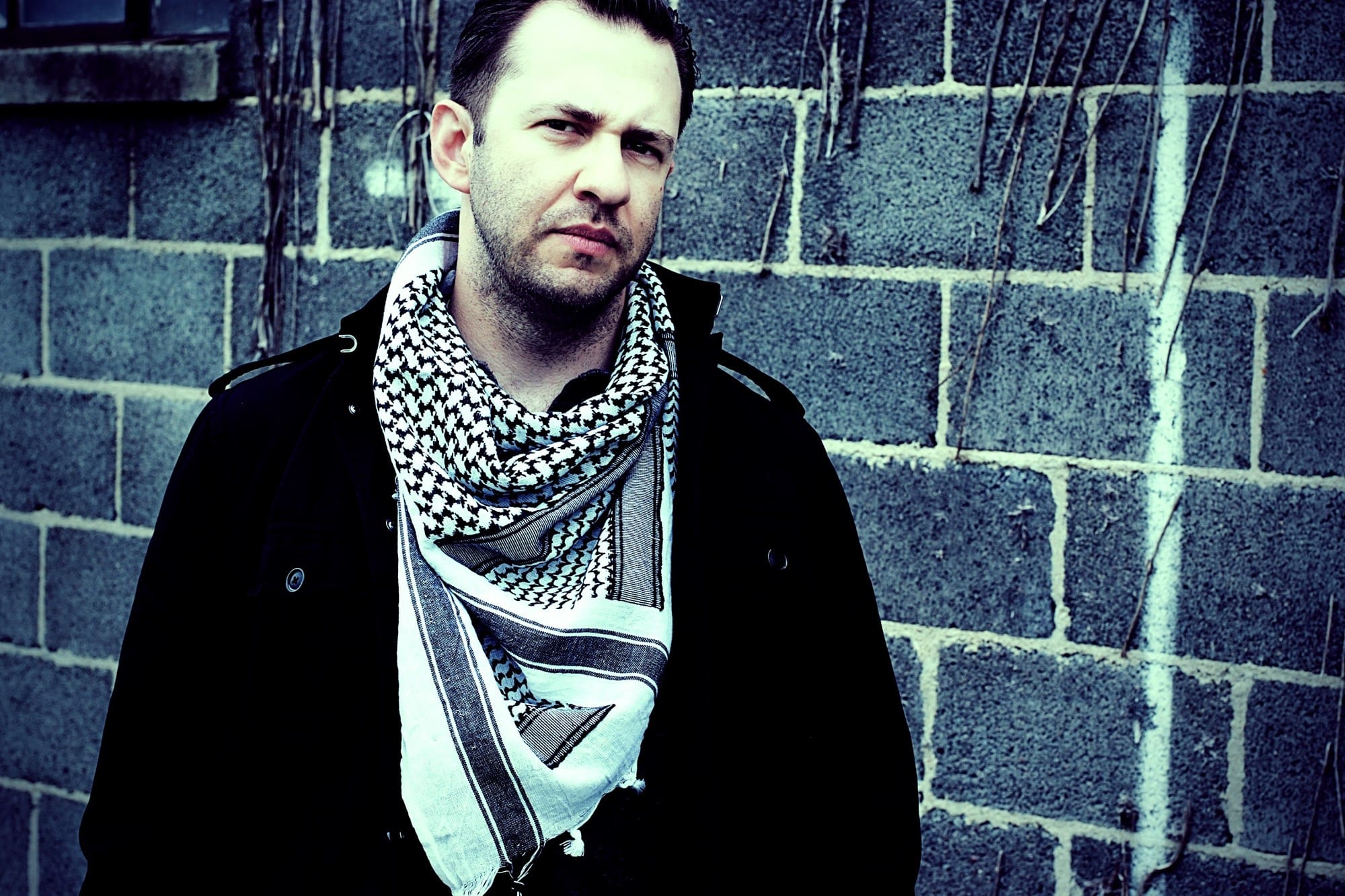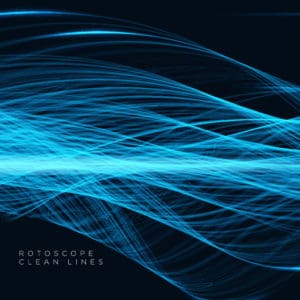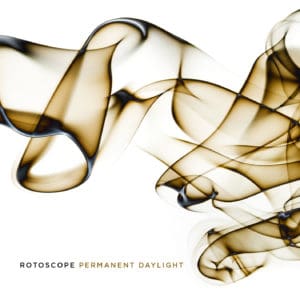
John Athayde has been the face of Rotoscope for over a decade now. Once a full band and now a solo project, Rotoscope finds inspiration from Depeche Mode, Portishead, and Brian Eno, mixing experimental sonic waves with guitar solos and moody pedals. Although Athayde is now settled down with his wife and children in Charlottesville, Virginia, he spent much of his early musician life in Washington D.C. as a member of various bands including Honor By August and Juniper Lane – a band that famously opened for Coldplay during their successful Viva La Vida tour.
Now, Athayde is focusing on putting the finishing touches on a project that’s spanned over a decade, Permanent Daylight. Various setbacks prevented the album from fully coming together for years, but the final result proves it was certainly worth the wait. The lead single “Clean Lines” combines angsty keyboard loops and blips that slowly transform into optimistic-sounding guitar hooks and a killer chorus. Athayde has managed to find forward-thinking pop bliss in deep experimentation with sound, tone, and mood. The music video for “Clean Lines,” directed by Ryan Downing, makes its world premiere here. Permanent Daylight will be released in early 2020.
I wanted to say that I really feel that you’re such a great songwriter and love how you craft melodies. First, I know your upcoming record Permanent Daylight has a bit of history in terms of how long it took to come together, so could you tell me what the process was like making it?
John Athayde of Rotoscope: It’s one of those things that became an unintentional side project that would just not give up. More than once it was referenced as my Chinese Democracy, the Guns N Roses record [which was over a decade in the making], which did actually finally come out. I was hoping we would beat them, but alas it did finally come out. Rotoscope as a full band ended somewhere in 2004. The original lineup kind of fell apart and I had started tracking some of it myself and some of the band members were involved in tracking it too.
At that point, I joined a band called Honor by August and then toured with them on the East Coast. I joined up with Juniper Lane and was a member with them. Now we’re on permanent pause ‘cause everyone’s all over the country and older, but the record was intermittently worked on in 2004, 2005, and 2006. The record was 85, 90% done by 2008. A lot of the song ideas go back as snippets that were started as [early] as 1999, or 1998 even, which is basically ancient as far as music is concerned. A lot of songs kept evolving. Some songs stayed pretty close to their original form, a lot was instrumentation changes. Some were straight up played by a live band. Then we realized we didn’t need to worry about it being played live, so I thought, what do we do now that we have six keyboards tacked up on the wall? How do I make cool sounds now? A lot of the songs didn’t change so much as inform but changed in character.
That makes a lot of sense considering you were probably in a different place in your life in 2004 as you are now. So I’m wondering what made you choose “Clean Lines” as the lead single for this record?
John Athayde of Rotoscope: “Clean Lines” is the first song actually that started with more of the sampling more of the digital world. And evolved out of a sketch with a new piece of software that I was trying to learn. The original take of it sounds very much like “Songs of Devotion” by Depeche Mode. It’s very dark and very Dave Gahan. It’s like, I’m going to mope and be sad now, but that doesn’t work too well when you’re playing a live show, so I tried to bring a lot more guitar into it. I started playing a lot more with actual samples. The guitar riff that starts out is normally a lot faster, but kicking it down an octave suddenly gives at gravitas and a better vibe, and I thought, okay this sounds a little bit cooler now.
Lots and lots and lots and lots of little pieces went into the first track that went into Pro Tools. We were on a much smaller Pro Tools system and we kept layering with this little piece, this little piece, and the guy said, “You’re out of tracks dude we can’t add anymore!” To your question, it really was the first time those two things came together. That song has probably one of the best verse and chorus of all the songs. It also kind of lyrically fits the whole vibe of the record – this digital disconnect and all the stuff going on.
With that song in particular, I really hear the Depeche Mode influence. It has the Depeche Mode sound, but with really strong U2-esque guitar. I’m not surprised that Brian Eno is an influence of yours. It mixes really well and it’s a great single to start off. That leads me to my next question, it seems like your music has such an emphasis on leaning into the shifting sonic landscape with sampling, remixing loops, and the use of pedals. So I wonder what most inspires that approach to songwriting?
John Athayde of Rotoscope: Oh wow. For me, I will be the first to admit I’m not a great singer-songwriter in the same sense that Ed Sheeran can just sit down and write with an acoustic guitar something great. I’m never going to make it as a BMI songwriter; it’s not my forte. To me, a lot of the writing starts with, that’s a cool noise, or that’s a cool sound. In Juniper Lane, that was my job: to be the sonic mad man. Like, the band is doing this now, so I’m going to turn this knob over here and make something cool happen. And that’s the excitement to me. How I could take up this sound and what I could do with it.
A great example of that is the instrumentation that leads off the record called “Apollo,” which definitely references the Eno record of the same name. There’s a high-pitched sound that goes ee-ee-ee and that’s one pedal that’s generating a solid tone and me pitch-shifting it with another pedal. In a sense, that’s what these things can do and how we can combine them in weird ways that makes people say, “That’s not the right way to do it, but hey that sounds cool.” You hear that a lot in “Epilogue” and the Crowded House cover we did. I have this old 80s Hardware called an A2 from Korg and if you bow it with a cello bow with a guitar through that, it does the swirly pad with other things that happen and it’s very Sigur Ros in a way.
Again you keep turning knobs until something sounds cool. Some people really know how to use their hardware, but I guess. Sometimes it sounds cool you turn it one way and then turn it back until it sounds cool. It’s just an experimentation. It’s a fascination with what I can make a machine do. Like how to make a flute or to use an acoustic guitar and play that backwards and run it through than this weird effect is that cool to me. More than half the time, the answer is no that’s awful, but there are times when that sounds super amazing. Let’s go with that.
That’s really interesting. So much of the songwriting process is just diving into the experimentation of sound and what instinctually sounds interesting to you.
John Athayde of Rotoscope: Yes and lyrics are the last thing to happen on every song. Usually I will have a song and I will have the melody that feels right and I will just sit there and write until I say, okay I like this take of the verse. I’ll cut different things together before doing a final vocal take. I don’t know necessarily what I want to say and that’s how I find it out.
Interesting. The bio on your website has a sentence I totally love. It says regarding your most recent record, “Imagine Trent Reznor’s film scores with an added focus on melody and song craft.” This is really fascinating to me because I also know that you’re a filmmaker. Do you intentionally like to make music that you feel could accompany a film?
John Athayde of Rotoscope: Oh totally. I’ve often said the line, “I dream in Panavision.” It came out in a lyric section 15 years ago. Panavision is like what you see in old movies. It’s very much that wide Cinemascope vibe. There’s so much about does what sound does with the visual especially music. Just think of the great music scores from everything to John Williams’ Star Wars or the weird Hitchcock scores and how critical that sound is. If you take the music out, it’s totally not the same. You lose so much of the energy and emotion is gone without it. So every song has a video in my head. We may never film that video. It would probably be impossible to film that video. But there’s always something visual in my head about our records.
Do you feel there’s a deeper connection between filmmaking and songwriting, or do they stimulate different parts of your brain? Do they coexist?
John Athayde of Rotoscope: Oh they coexist. I’m not sure if they’re collaborative or disparate, but they do co-exist. It’s kind of two different ways to tell a story, almost. The “Clean Lines” (video) specifically has a lot of visuals from that that are from some trips to New York from the late 90s, early 2000s, jjust being down in the Village as the fog had rolled in and you couldn’t see anything. All that stuff visually jumps in my head when I’m listening to that song. Just like driving through parts of D.C. at night. The song spatially is urban. It’s very much a nighttime track. That’s the visual in my mind whenever I hear this song.
I know exactly what you mean. There are certain songs I feel like sound better when I’m driving my car, or sound better when I’m walking down the street by myself, or sound better at night, or sound better in the summer. Another thing that really interests me is that the Clean Lines EP, which came out just about two years ago, has been described “an audio scrapbook” of your life. How do you feel that your music has created this scrapbook?
John Athayde of Rotoscope: Well, every song is a vignette really. I’m not even telling you the whole story with these songs. These are a series of Polaroids perhaps. When a song is done, it’s very much a snapshot of my life at that time, especially the lyrics. Some of the lyrics are more recent on this album or much more mature. I’m not the 20-something person writing pining love songs. I’m in a very different position in life and some things have changed in that way.
So I look back I say, oh yeah that jam. I know what I’m talkin about there. A lot of the songs on, let’s say the second half of the record more so are very much the original band lineup. I was dating the other singer at the time. There’s a couple songs back and forth that are very much about each other. It’s very awkward, especially when you show up to practice and it’s 2003 and you’re like, I have a new song and the other person says, “Oh crap, this is going to be a lot.”
So basically this was like Fleetwood Mac’s Rumours. *laughs*
John Athayde of Rotoscope: The second half is very much that, yes. *laughs* “Sing Yourself To Sleep,” “Epilogue,” “Jawbone Hill” – those are very much little daggers to say it nicely. It’s interesting looking back at it. I don’t have any ill feelings, but it’s interesting to see where I was at that time. From a scrapbook is looking back and saying, oh I remember that what I was doing where I was in my life.
It makes a lot of sense talking to you how you approach songs and how the audio and visual makes a sensory experience of music that is kind of overlapping. You kind of briefly touched upon this, but we’re premiering the music video for “Clean Lines” – what can you tell us about the concept behind the video? You mentioned that some are about walking in New York, when writing that so did you have a clear image of what you wanted that song to look like in the video?
John Athayde of Rotoscope: No, it was very much it has the gritty individual vibe of what I was going for as a concept, but that’s what’s weird about collaboration. When you throw the idea out there to someone else, they create something that’s totally different and that’s totally awesome. A couple of things kind of really fed into the storyline of the verses and things. I always hate to tell too much of this because the best part of the songs is what people bring to them.
My sister was working on various film projects as a key PA and assistant film director, and she’d be on set just talking about how so many of these people, these big famous people who are in the spotlight non-stop retreat to their trailers, want to disappear and just want to go home to be with their families. So much of the empire of Hollywood is about how these people are constantly have the paparazzi in their face and they’re disconnected from real relationships half the time because they don’t know why people are talking to them do they want something. So much of the lyrics fed into that.
In a literal sense, I was thinking that with the video idea, but when I started working with Ryan Downing. We had to shoot in Savannah not New York, so it limits our grittiness. *laughs* Interior shots we did outside the studio where our producer Ted works and there’s a lot of exposed brick, so we got some cool shots there. It’s in the basement at the old part of town, so we got a good vibe and history. So we kind of walked around at night thinking about what we could do outside. I didn’t want anything noticeably pointing to Savannah, but getting that urban vibe and texture was good, but Ryan took it to a whole new level in post with so much of the overlay and texturing. It really brings out the complexity and grittiness I was looking for and a different cool way.
It makes a lot of sense that you kind of have to adjust and figure out how to make Savannah look a bit more gritty. So my last question is, so many of these songs we’ve talked about far from a different part of your life and had happened what feels like so long ago. So, how are the songs and the music you write now feel different? Do you feel like at the core you approach them similarly, but maybe from a more mature place? How would you describe your songwriting now compared to back then?
John Athayde of Rotoscope: I would break it into two parts. Sonically I would say I’m less concerned about what people think or say. I’m more apt to say we’re going to try this totally weird thing and who cares if it’s only 2 minutes long, that’s the song. It doesn’t need to be the perfect 3 and 1/2 minute pop song with the perfect verse, chorus, bridge and hook and everybody’s happy. It’s a little bit more like whatever the song wants to be, that’s what it is. And I’d say lyrically, there’s probably a maturity that just comes with being older.
I’d say there’s more hope lyrically in some of the stuff I’ve done more recently. But there’s a big girth. In 2008, when I was in Juniper Lane, we opened for Coldplay at the Verizon Center and the next day the girl I was dating suffered a fatal aneurysm. I didn’t write lyrics for 5 years. So coming out of that has been weird. There’s still a bit of dancing around that. I’m still not ready to rip that band-aid off in some ways. I think there’s just more hope in general looking at the stuff that comes out now. It seems to be more optimistic now.
I love that. You would think a more cynical person would say, oh as you get older, you awaken more to the horrors of the world, but I like that you have an opposite approach. As you’ve gotten older you’ve gotten more optimistic as opposed to cynical about things.
John Athayde of Rotoscope: You’re more awake to it, but it’s more of a reason to have hope. Just having kids and stuff, why would you have kids and stuff if you didn’t have hope in the future?
That’s so true. Well, thanks for chatting with me today. I really look forward to having people hear Permanent Daylight in its entirety.
Me too! Thank you.




